University Nursing Case Study: Betty White's Healthcare Analysis
VerifiedAdded on 2020/03/04
|11
|2953
|230
Case Study
AI Summary
This case study analyzes the care provided to Mrs. Betty White, an 85-year-old woman admitted to the hospital with pneumonia. The assignment details the patient's medical history, admission, and subsequent complications, including a fractured femur and infection. It identifies breaches of the National Safety and Quality Health Service Standards, particularly in governance, infection control, and medication safety. The analysis discusses how adherence to Standards 1 (Governance) and 4 (Medication Safety) could have improved patient outcomes. It emphasizes the importance of patient-centered care, ethical principles, and effective communication. The study highlights the need for improved nursing practices, documentation, and adherence to established standards to ensure patient safety and quality of care. The case study underscores the impact of inadequate care on patient outcomes and the necessity of implementing comprehensive healthcare strategies.
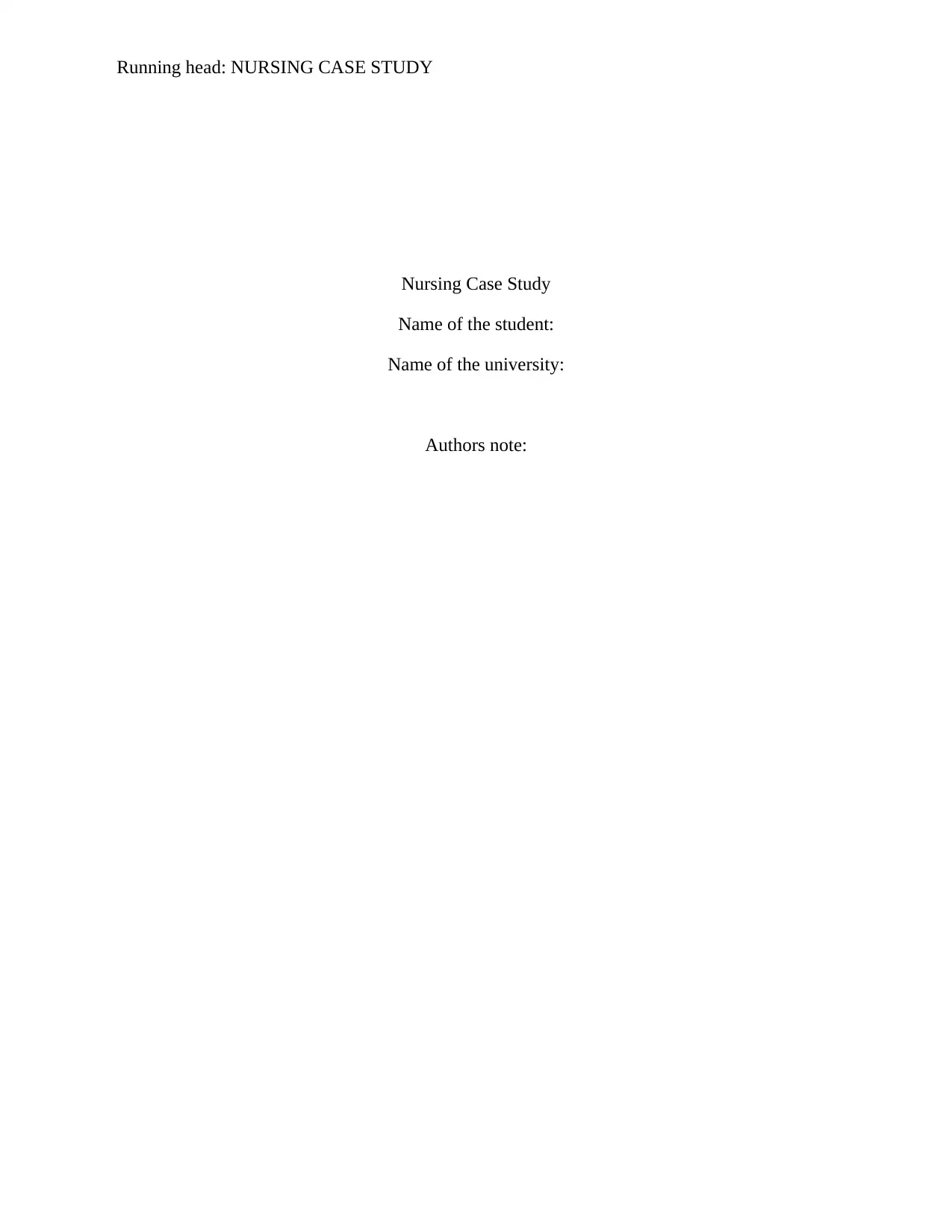
Running head: NURSING CASE STUDY
Nursing Case Study
Name of the student:
Name of the university:
Authors note:
Nursing Case Study
Name of the student:
Name of the university:
Authors note:
Paraphrase This Document
Need a fresh take? Get an instant paraphrase of this document with our AI Paraphraser
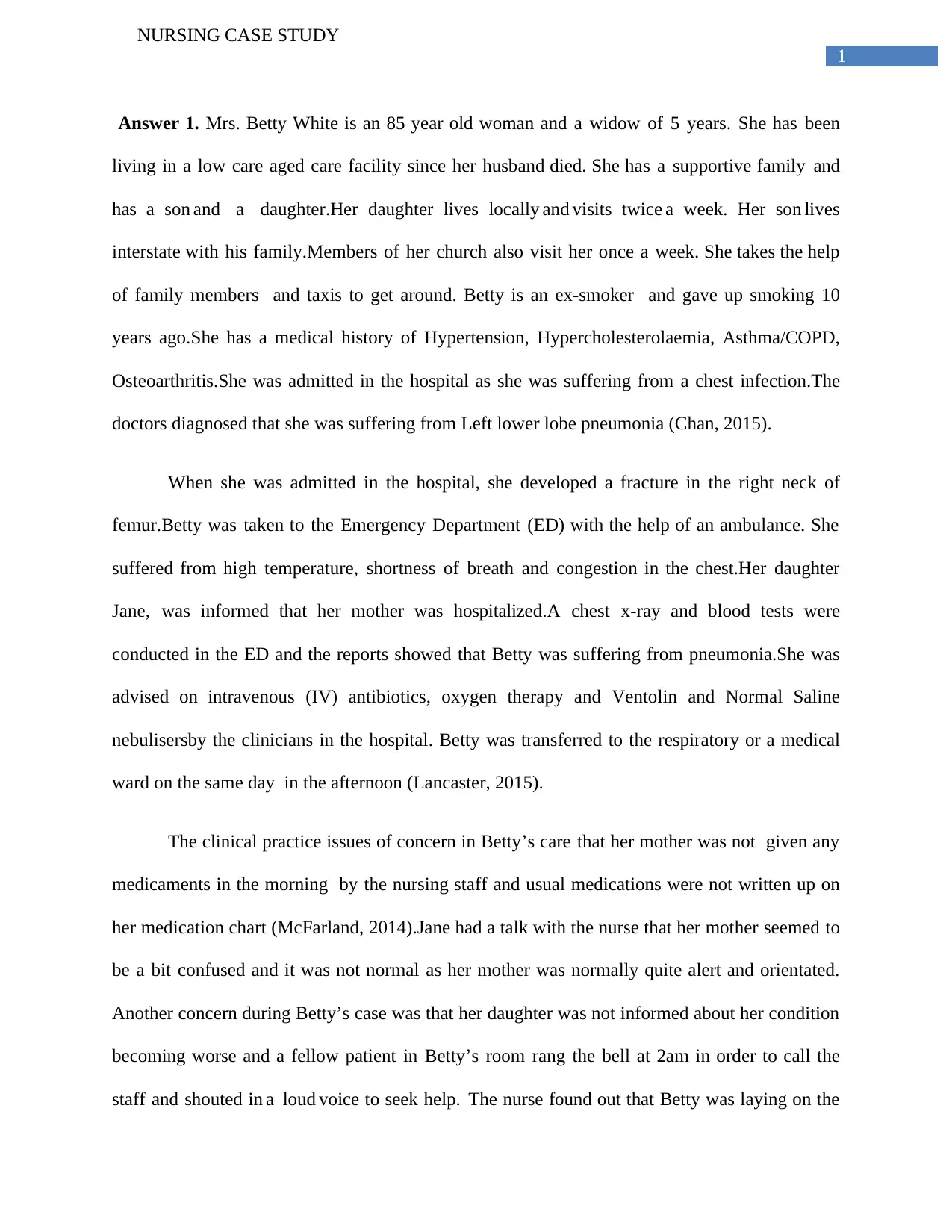
1
NURSING CASE STUDY
Answer 1. Mrs. Betty White is an 85 year old woman and a widow of 5 years. She has been
living in a low care aged care facility s ince her husband died. She has a support ive family and
has a son and a daughter.Her daughter lives loca lly and visits tw ice a week. Her son lives
interstate w ith his family.Members of her church also v is it her once a week. She takes the help
of family members and taxis to get around. Betty is an ex-smoker and gave up smoking 10
years ago.She has a medical history of Hypertension, Hypercholesterolaemia, Asthma/COPD,
Osteoarthritis.She was adm itted in the hospital as she was suffering from a chest infect ion.The
doctors diagnosed that she was suffering from Left lower lobe pneumonia (Chan, 2015).
Wh en she was admitted in the hosp ita l, she developed a fracture in the r ight neck of
femur.Betty was taken to the Emergency Department (ED) with the help of an ambulance. She
suffered from high temperature, shortness of breath and congest ion in the chest.Her daughter
Jane , was informed that her mother was hospitalized.A chest x-ray and blood tests were
conducted in the ED and the reports showed that Betty was suffering from pneumonia.She was
advised on intravenous (IV) antibiot ics , oxygen therapy and Vento lin and Norma l Saline
nebulisersby the clinicians in the hospital. Betty was transferred to the resp iratory or a medical
ward on the same day in the afternoon (Lancaster, 2015).
The clinical practice issues of concern in Betty’s care that her mother was not given any
medicaments in the morning by the nursing staff and usua l med icat ions were not written up on
her med icat ion chart (McFarland, 2014).Jane had a talk with the nurse that her mother seemed to
be a bit confused and it was not normal as her mother was norma lly quite a lert and or ientated.
Another concern during Betty’s case was that her daughter was not informed about her condition
becoming worse and a fellow patient in Betty’s room rang the be ll at 2am in order to call the
staff and shouted in a loud vo ice to seek he lp. The nurse found out that Betty was laying on the
NURSING CASE STUDY
Answer 1. Mrs. Betty White is an 85 year old woman and a widow of 5 years. She has been
living in a low care aged care facility s ince her husband died. She has a support ive family and
has a son and a daughter.Her daughter lives loca lly and visits tw ice a week. Her son lives
interstate w ith his family.Members of her church also v is it her once a week. She takes the help
of family members and taxis to get around. Betty is an ex-smoker and gave up smoking 10
years ago.She has a medical history of Hypertension, Hypercholesterolaemia, Asthma/COPD,
Osteoarthritis.She was adm itted in the hospital as she was suffering from a chest infect ion.The
doctors diagnosed that she was suffering from Left lower lobe pneumonia (Chan, 2015).
Wh en she was admitted in the hosp ita l, she developed a fracture in the r ight neck of
femur.Betty was taken to the Emergency Department (ED) with the help of an ambulance. She
suffered from high temperature, shortness of breath and congest ion in the chest.Her daughter
Jane , was informed that her mother was hospitalized.A chest x-ray and blood tests were
conducted in the ED and the reports showed that Betty was suffering from pneumonia.She was
advised on intravenous (IV) antibiot ics , oxygen therapy and Vento lin and Norma l Saline
nebulisersby the clinicians in the hospital. Betty was transferred to the resp iratory or a medical
ward on the same day in the afternoon (Lancaster, 2015).
The clinical practice issues of concern in Betty’s care that her mother was not given any
medicaments in the morning by the nursing staff and usua l med icat ions were not written up on
her med icat ion chart (McFarland, 2014).Jane had a talk with the nurse that her mother seemed to
be a bit confused and it was not normal as her mother was norma lly quite a lert and or ientated.
Another concern during Betty’s case was that her daughter was not informed about her condition
becoming worse and a fellow patient in Betty’s room rang the be ll at 2am in order to call the
staff and shouted in a loud vo ice to seek he lp. The nurse found out that Betty was laying on the
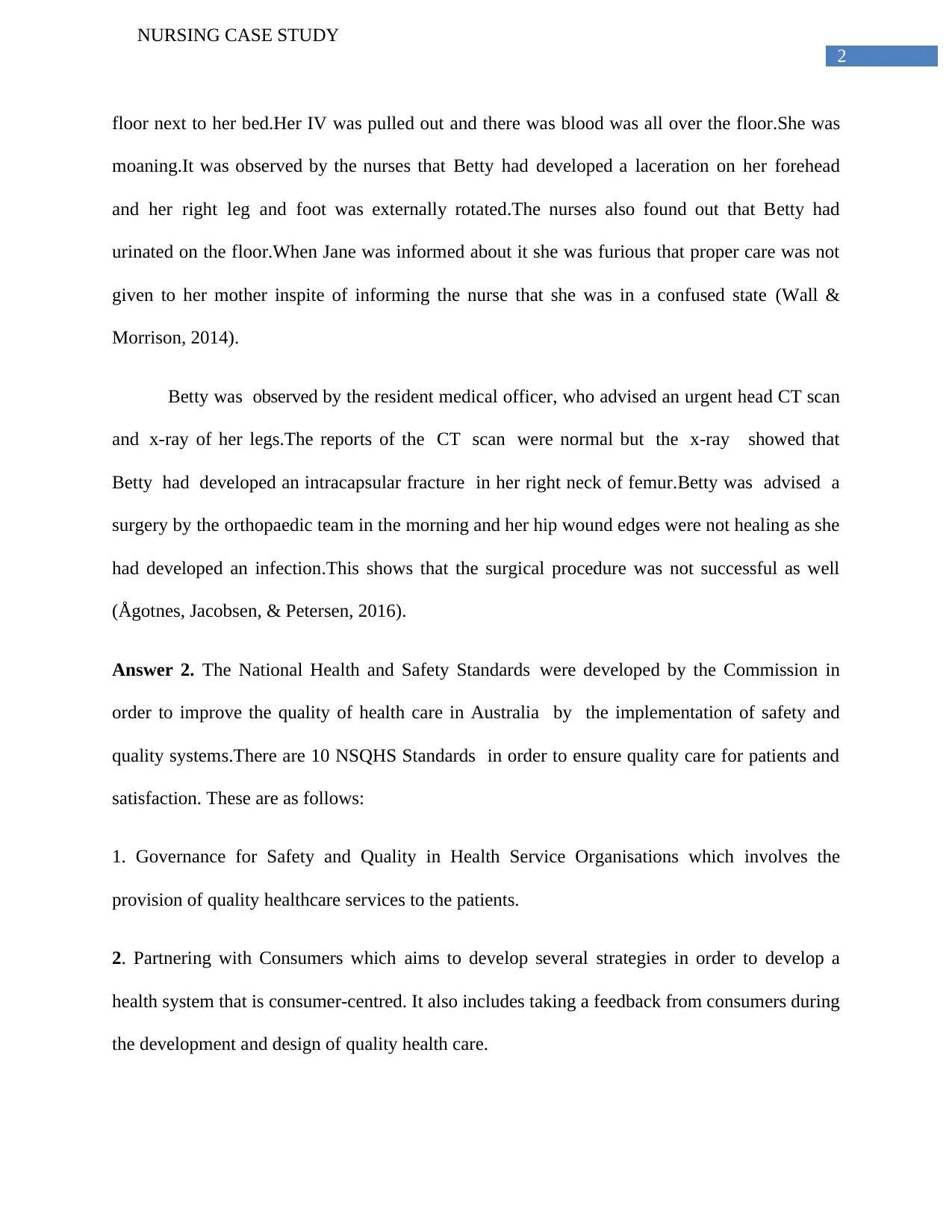
2
NURSING CASE STUDY
f loor next to her bed.Her IV was pu lled out and there was blood was a ll over the f loor.She was
moaning.It was observed by the nurses that Betty had developed a laceration on her forehead
and her r ight leg and foot was externa lly rotated.The nurses also found out that Betty had
ur inated on the f loor.When Jane was informed about it she was furious that proper care was not
given to her mother inspite of informing the nurse that she was in a confused state (Wall &
Morrison, 2014).
Betty was observed by the res ident medical off icer , who advised an urgent head CT scan
and x-ray of her legs.The reports of the CT scan were normal but the x-ray showed that
Betty had developed an intracapsu lar fracture in her r ight neck of femur.Betty was advised a
surgery by the orthopaedic team in the morn ing and her hip wound edges were not healing as she
had developed an infection.This shows that the surgical procedure was not successful as well
(Ågotnes, Jacobsen, & Petersen, 2016).
Answer 2. The National Health and Safety Standards were developed by the Commission in
order to improve the quality of health care in Australia by the implementation of safety and
quality systems.There are 10 NSQHS Standards in order to ensure quality care for patients and
satisfaction. These are as follows:
1. Governance for Safety and Quality in Health Service Organisations which involves the
provision of quality healthcare services to the patients.
2. Partnering with Consumers which aims to develop several strategies in order to develop a
health system that is consumer-centred. It also includes taking a feedback from consumers during
the development and design of quality health care.
NURSING CASE STUDY
f loor next to her bed.Her IV was pu lled out and there was blood was a ll over the f loor.She was
moaning.It was observed by the nurses that Betty had developed a laceration on her forehead
and her r ight leg and foot was externa lly rotated.The nurses also found out that Betty had
ur inated on the f loor.When Jane was informed about it she was furious that proper care was not
given to her mother inspite of informing the nurse that she was in a confused state (Wall &
Morrison, 2014).
Betty was observed by the res ident medical off icer , who advised an urgent head CT scan
and x-ray of her legs.The reports of the CT scan were normal but the x-ray showed that
Betty had developed an intracapsu lar fracture in her r ight neck of femur.Betty was advised a
surgery by the orthopaedic team in the morn ing and her hip wound edges were not healing as she
had developed an infection.This shows that the surgical procedure was not successful as well
(Ågotnes, Jacobsen, & Petersen, 2016).
Answer 2. The National Health and Safety Standards were developed by the Commission in
order to improve the quality of health care in Australia by the implementation of safety and
quality systems.There are 10 NSQHS Standards in order to ensure quality care for patients and
satisfaction. These are as follows:
1. Governance for Safety and Quality in Health Service Organisations which involves the
provision of quality healthcare services to the patients.
2. Partnering with Consumers which aims to develop several strategies in order to develop a
health system that is consumer-centred. It also includes taking a feedback from consumers during
the development and design of quality health care.
⊘ This is a preview!⊘
Do you want full access?
Subscribe today to unlock all pages.

Trusted by 1+ million students worldwide
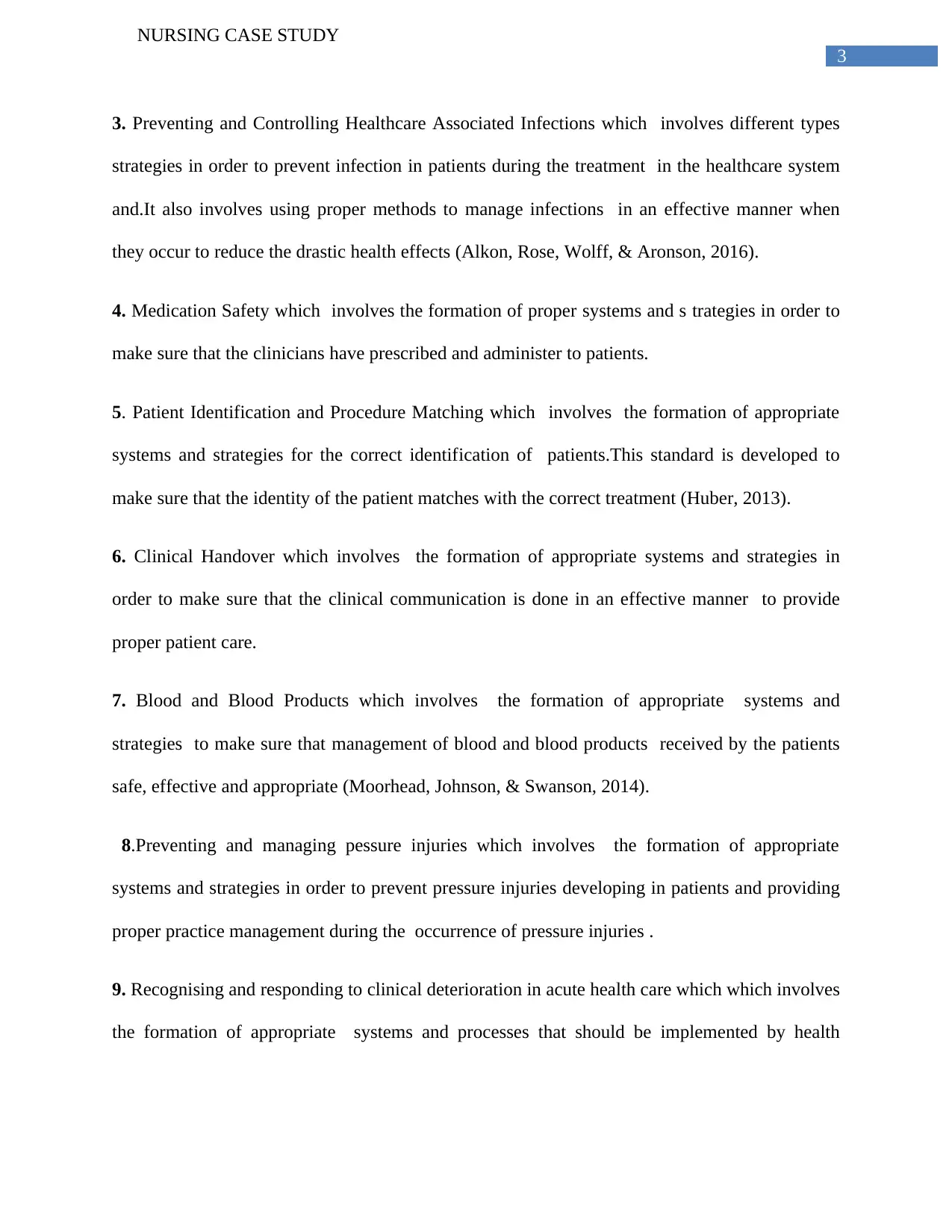
3
NURSING CASE STUDY
3. Preventing and Controlling Healthcare Associated Infections which involves different types
strategies in order to prevent infection in patients during the treatment in the healthcare system
and.It also involves using proper methods to manage infections in an effective manner when
they occur to reduce the drastic health effects (Alkon, Rose, Wolff, & Aronson, 2016).
4. Medication Safety which involves the formation of proper systems and s trategies in order to
make sure that the clinicians have prescribed and administer to patients.
5. Patient Identification and Procedure Matching which involves the formation of appropriate
systems and strategies for the correct identification of patients.This standard is developed to
make sure that the identity of the patient matches with the correct treatment (Huber, 2013).
6. Clinical Handover which involves the formation of appropriate systems and strategies in
order to make sure that the clinical communication is done in an effective manner to provide
proper patient care.
7. Blood and Blood Products which involves the formation of appropriate systems and
strategies to make sure that management of blood and blood products received by the patients
safe, effective and appropriate (Moorhead, Johnson, & Swanson, 2014).
8.Preventing and managing pessure injuries which involves the formation of appropriate
systems and strategies in order to prevent pressure injuries developing in patients and providing
proper practice management during the occurrence of pressure injuries .
9. Recognising and responding to clinical deterioration in acute health care which which involves
the formation of appropriate systems and processes that should be implemented by health
NURSING CASE STUDY
3. Preventing and Controlling Healthcare Associated Infections which involves different types
strategies in order to prevent infection in patients during the treatment in the healthcare system
and.It also involves using proper methods to manage infections in an effective manner when
they occur to reduce the drastic health effects (Alkon, Rose, Wolff, & Aronson, 2016).
4. Medication Safety which involves the formation of proper systems and s trategies in order to
make sure that the clinicians have prescribed and administer to patients.
5. Patient Identification and Procedure Matching which involves the formation of appropriate
systems and strategies for the correct identification of patients.This standard is developed to
make sure that the identity of the patient matches with the correct treatment (Huber, 2013).
6. Clinical Handover which involves the formation of appropriate systems and strategies in
order to make sure that the clinical communication is done in an effective manner to provide
proper patient care.
7. Blood and Blood Products which involves the formation of appropriate systems and
strategies to make sure that management of blood and blood products received by the patients
safe, effective and appropriate (Moorhead, Johnson, & Swanson, 2014).
8.Preventing and managing pessure injuries which involves the formation of appropriate
systems and strategies in order to prevent pressure injuries developing in patients and providing
proper practice management during the occurrence of pressure injuries .
9. Recognising and responding to clinical deterioration in acute health care which which involves
the formation of appropriate systems and processes that should be implemented by health
Paraphrase This Document
Need a fresh take? Get an instant paraphrase of this document with our AI Paraphraser
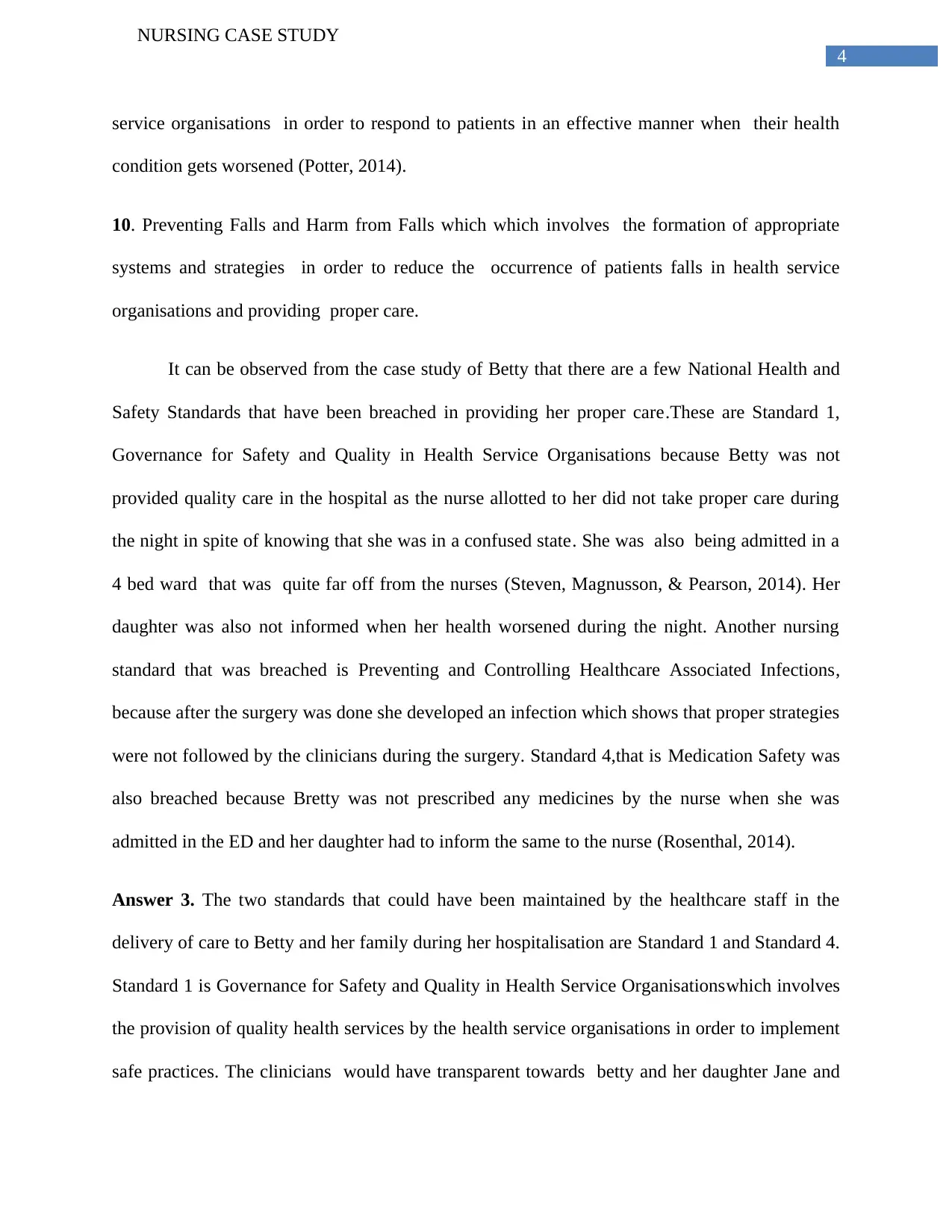
4
NURSING CASE STUDY
service organisations in order to respond to patients in an effective manner when their health
condition gets worsened (Potter, 2014).
10. Preventing Falls and Harm from Falls which which involves the formation of appropriate
systems and strategies in order to reduce the occurrence of patients falls in health service
organisations and providing proper care.
It can be observed from the case study of Betty that there are a few National Health and
Safety Standards that have been breached in providing her proper care.These are Standard 1,
Governance for Safety and Quality in Health Service Organisations because Betty was not
provided quality care in the hospital as the nurse allotted to her did not take proper care during
the night in spite of knowing that she was in a confused state. She was also being admitted in a
4 bed ward that was quite far off from the nurses (Steven, Magnusson, & Pearson, 2014). Her
daughter was also not informed when her health worsened during the night. Another nursing
standard that was breached is Preventing and Controlling Healthcare Associated Infections,
because after the surgery was done she developed an infection which shows that proper strategies
were not followed by the clinicians during the surgery. Standard 4,that is Medication Safety was
also breached because Bretty was not prescribed any medicines by the nurse when she was
admitted in the ED and her daughter had to inform the same to the nurse (Rosenthal, 2014).
Answer 3. The two standards that could have been maintained by the healthcare staff in the
delivery of care to Betty and her family during her hospitalisation are Standard 1 and Standard 4.
Standard 1 is Governance for Safety and Quality in Health Service Organisationswhich involves
the provision of quality health services by the health service organisations in order to implement
safe practices. The clinicians would have transparent towards betty and her daughter Jane and
NURSING CASE STUDY
service organisations in order to respond to patients in an effective manner when their health
condition gets worsened (Potter, 2014).
10. Preventing Falls and Harm from Falls which which involves the formation of appropriate
systems and strategies in order to reduce the occurrence of patients falls in health service
organisations and providing proper care.
It can be observed from the case study of Betty that there are a few National Health and
Safety Standards that have been breached in providing her proper care.These are Standard 1,
Governance for Safety and Quality in Health Service Organisations because Betty was not
provided quality care in the hospital as the nurse allotted to her did not take proper care during
the night in spite of knowing that she was in a confused state. She was also being admitted in a
4 bed ward that was quite far off from the nurses (Steven, Magnusson, & Pearson, 2014). Her
daughter was also not informed when her health worsened during the night. Another nursing
standard that was breached is Preventing and Controlling Healthcare Associated Infections,
because after the surgery was done she developed an infection which shows that proper strategies
were not followed by the clinicians during the surgery. Standard 4,that is Medication Safety was
also breached because Bretty was not prescribed any medicines by the nurse when she was
admitted in the ED and her daughter had to inform the same to the nurse (Rosenthal, 2014).
Answer 3. The two standards that could have been maintained by the healthcare staff in the
delivery of care to Betty and her family during her hospitalisation are Standard 1 and Standard 4.
Standard 1 is Governance for Safety and Quality in Health Service Organisationswhich involves
the provision of quality health services by the health service organisations in order to implement
safe practices. The clinicians would have transparent towards betty and her daughter Jane and
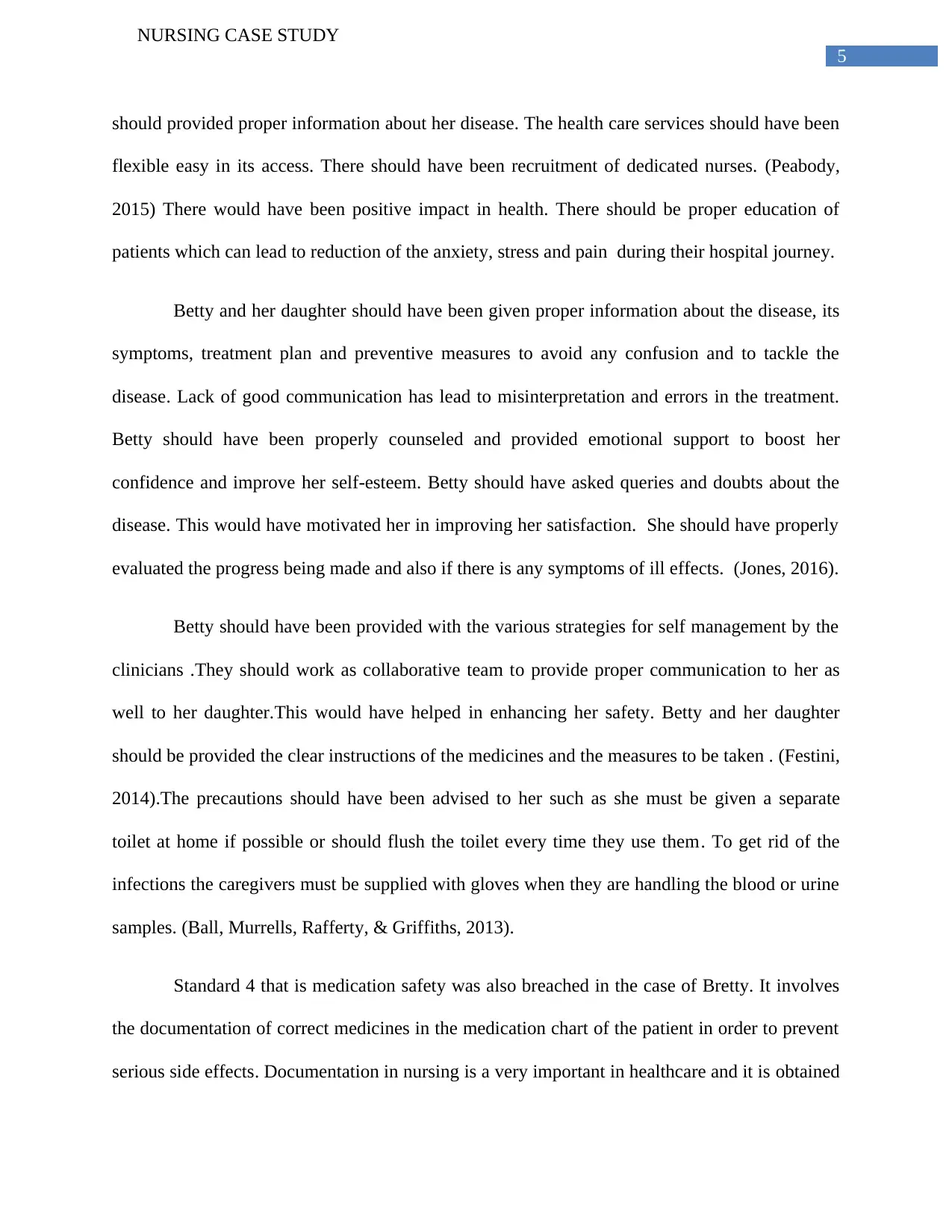
5
NURSING CASE STUDY
should provided proper information about her disease. The health care services should have been
flexible easy in its access. There should have been recruitment of dedicated nurses. (Peabody,
2015) There would have been positive impact in health. There should be proper education of
patients which can lead to reduction of the anxiety, stress and pain during their hospital journey.
Betty and her daughter should have been given proper information about the disease, its
symptoms, treatment plan and preventive measures to avoid any confusion and to tackle the
disease. Lack of good communication has lead to misinterpretation and errors in the treatment.
Betty should have been properly counseled and provided emotional support to boost her
confidence and improve her self-esteem. Betty should have asked queries and doubts about the
disease. This would have motivated her in improving her satisfaction. She should have properly
evaluated the progress being made and also if there is any symptoms of ill effects. (Jones, 2016).
Betty should have been provided with the various strategies for self management by the
clinicians .They should work as collaborative team to provide proper communication to her as
well to her daughter.This would have helped in enhancing her safety. Betty and her daughter
should be provided the clear instructions of the medicines and the measures to be taken . (Festini,
2014).The precautions should have been advised to her such as she must be given a separate
toilet at home if possible or should flush the toilet every time they use them. To get rid of the
infections the caregivers must be supplied with gloves when they are handling the blood or urine
samples. (Ball, Murrells, Rafferty, & Griffiths, 2013).
Standard 4 that is medication safety was also breached in the case of Bretty. It involves
the documentation of correct medicines in the medication chart of the patient in order to prevent
serious side effects. Documentation in nursing is a very important in healthcare and it is obtained
NURSING CASE STUDY
should provided proper information about her disease. The health care services should have been
flexible easy in its access. There should have been recruitment of dedicated nurses. (Peabody,
2015) There would have been positive impact in health. There should be proper education of
patients which can lead to reduction of the anxiety, stress and pain during their hospital journey.
Betty and her daughter should have been given proper information about the disease, its
symptoms, treatment plan and preventive measures to avoid any confusion and to tackle the
disease. Lack of good communication has lead to misinterpretation and errors in the treatment.
Betty should have been properly counseled and provided emotional support to boost her
confidence and improve her self-esteem. Betty should have asked queries and doubts about the
disease. This would have motivated her in improving her satisfaction. She should have properly
evaluated the progress being made and also if there is any symptoms of ill effects. (Jones, 2016).
Betty should have been provided with the various strategies for self management by the
clinicians .They should work as collaborative team to provide proper communication to her as
well to her daughter.This would have helped in enhancing her safety. Betty and her daughter
should be provided the clear instructions of the medicines and the measures to be taken . (Festini,
2014).The precautions should have been advised to her such as she must be given a separate
toilet at home if possible or should flush the toilet every time they use them. To get rid of the
infections the caregivers must be supplied with gloves when they are handling the blood or urine
samples. (Ball, Murrells, Rafferty, & Griffiths, 2013).
Standard 4 that is medication safety was also breached in the case of Bretty. It involves
the documentation of correct medicines in the medication chart of the patient in order to prevent
serious side effects. Documentation in nursing is a very important in healthcare and it is obtained
⊘ This is a preview!⊘
Do you want full access?
Subscribe today to unlock all pages.

Trusted by 1+ million students worldwide
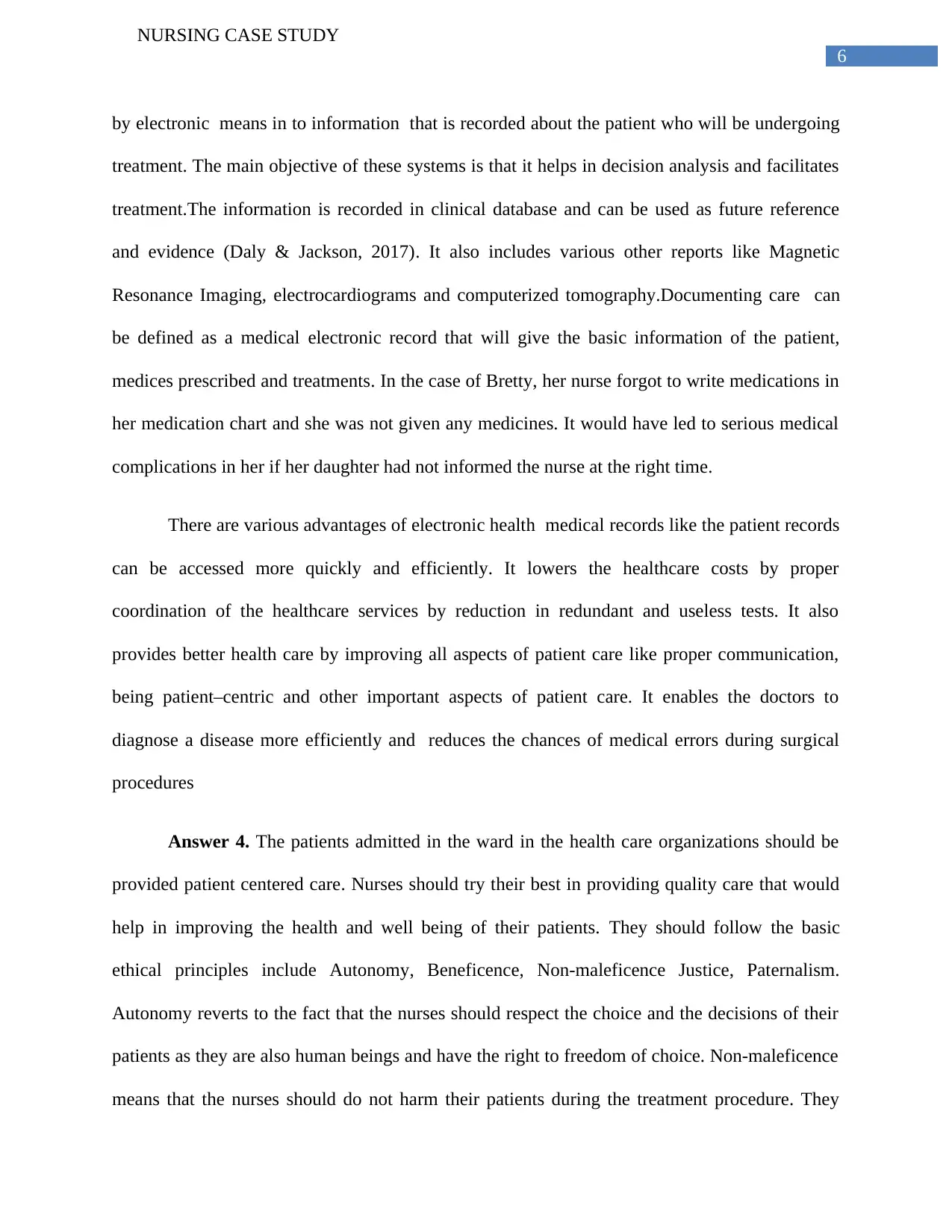
6
NURSING CASE STUDY
by electronic means in to information that is recorded about the patient who will be undergoing
treatment. The main objective of these systems is that it helps in decision analysis and facilitates
treatment.The information is recorded in clinical database and can be used as future reference
and evidence (Daly & Jackson, 2017). It also includes various other reports like Magnetic
Resonance Imaging, electrocardiograms and computerized tomography.Documenting care can
be defined as a medical electronic record that will give the basic information of the patient,
medices prescribed and treatments. In the case of Bretty, her nurse forgot to write medications in
her medication chart and she was not given any medicines. It would have led to serious medical
complications in her if her daughter had not informed the nurse at the right time.
There are various advantages of electronic health medical records like the patient records
can be accessed more quickly and efficiently. It lowers the healthcare costs by proper
coordination of the healthcare services by reduction in redundant and useless tests. It also
provides better health care by improving all aspects of patient care like proper communication,
being patient–centric and other important aspects of patient care. It enables the doctors to
diagnose a disease more efficiently and reduces the chances of medical errors during surgical
procedures
Answer 4. The patients admitted in the ward in the health care organizations should be
provided patient centered care. Nurses should try their best in providing quality care that would
help in improving the health and well being of their patients. They should follow the basic
ethical principles include Autonomy, Beneficence, Non-maleficence Justice, Paternalism.
Autonomy reverts to the fact that the nurses should respect the choice and the decisions of their
patients as they are also human beings and have the right to freedom of choice. Non-maleficence
means that the nurses should do not harm their patients during the treatment procedure. They
NURSING CASE STUDY
by electronic means in to information that is recorded about the patient who will be undergoing
treatment. The main objective of these systems is that it helps in decision analysis and facilitates
treatment.The information is recorded in clinical database and can be used as future reference
and evidence (Daly & Jackson, 2017). It also includes various other reports like Magnetic
Resonance Imaging, electrocardiograms and computerized tomography.Documenting care can
be defined as a medical electronic record that will give the basic information of the patient,
medices prescribed and treatments. In the case of Bretty, her nurse forgot to write medications in
her medication chart and she was not given any medicines. It would have led to serious medical
complications in her if her daughter had not informed the nurse at the right time.
There are various advantages of electronic health medical records like the patient records
can be accessed more quickly and efficiently. It lowers the healthcare costs by proper
coordination of the healthcare services by reduction in redundant and useless tests. It also
provides better health care by improving all aspects of patient care like proper communication,
being patient–centric and other important aspects of patient care. It enables the doctors to
diagnose a disease more efficiently and reduces the chances of medical errors during surgical
procedures
Answer 4. The patients admitted in the ward in the health care organizations should be
provided patient centered care. Nurses should try their best in providing quality care that would
help in improving the health and well being of their patients. They should follow the basic
ethical principles include Autonomy, Beneficence, Non-maleficence Justice, Paternalism.
Autonomy reverts to the fact that the nurses should respect the choice and the decisions of their
patients as they are also human beings and have the right to freedom of choice. Non-maleficence
means that the nurses should do not harm their patients during the treatment procedure. They
Paraphrase This Document
Need a fresh take? Get an instant paraphrase of this document with our AI Paraphraser
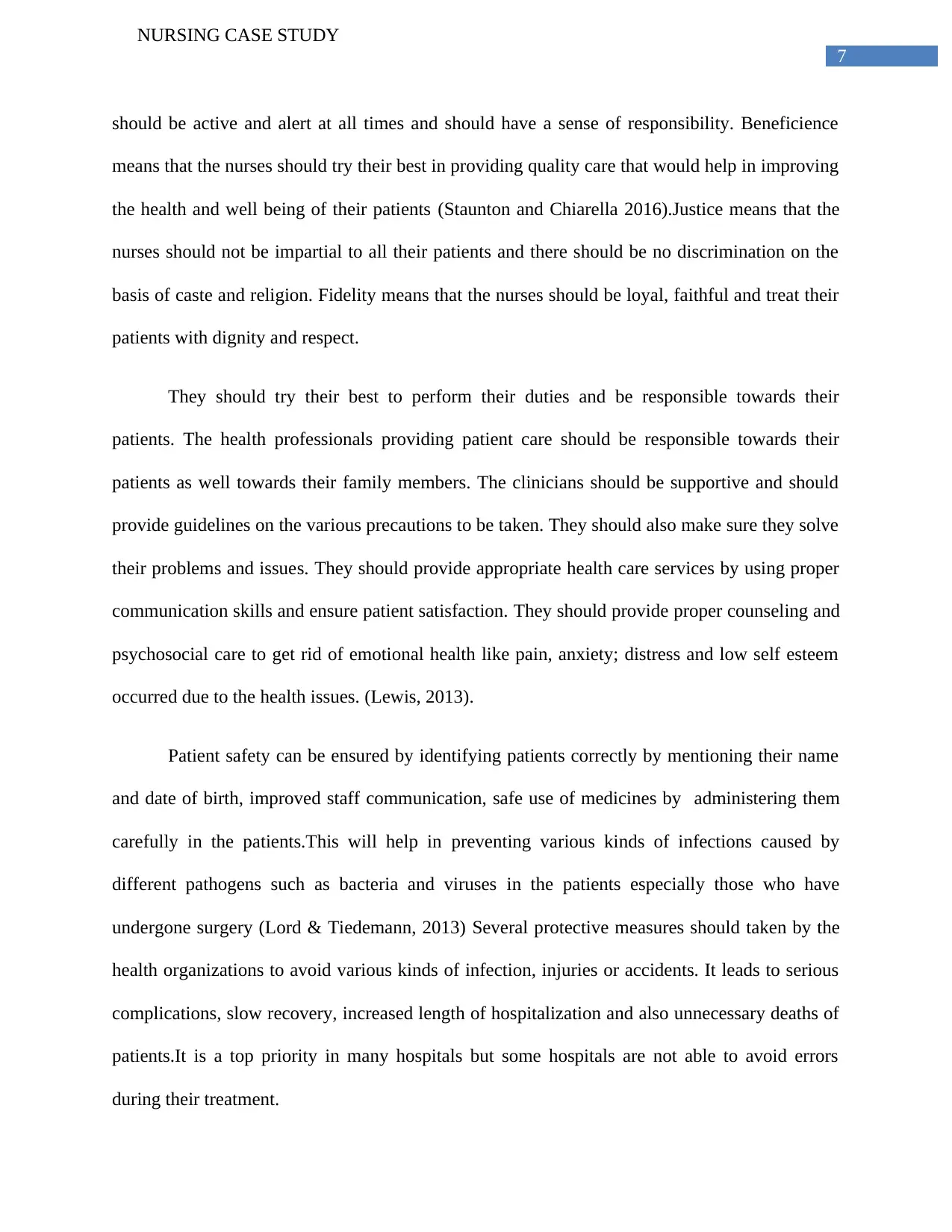
7
NURSING CASE STUDY
should be active and alert at all times and should have a sense of responsibility. Beneficience
means that the nurses should try their best in providing quality care that would help in improving
the health and well being of their patients (Staunton and Chiarella 2016).Justice means that the
nurses should not be impartial to all their patients and there should be no discrimination on the
basis of caste and religion. Fidelity means that the nurses should be loyal, faithful and treat their
patients with dignity and respect.
They should try their best to perform their duties and be responsible towards their
patients. The health professionals providing patient care should be responsible towards their
patients as well towards their family members. The clinicians should be supportive and should
provide guidelines on the various precautions to be taken. They should also make sure they solve
their problems and issues. They should provide appropriate health care services by using proper
communication skills and ensure patient satisfaction. They should provide proper counseling and
psychosocial care to get rid of emotional health like pain, anxiety; distress and low self esteem
occurred due to the health issues. (Lewis, 2013).
Patient safety can be ensured by identifying patients correctly by mentioning their name
and date of birth, improved staff communication, safe use of medicines by administering them
carefully in the patients.This will help in preventing various kinds of infections caused by
different pathogens such as bacteria and viruses in the patients especially those who have
undergone surgery (Lord & Tiedemann, 2013) Several protective measures should taken by the
health organizations to avoid various kinds of infection, injuries or accidents. It leads to serious
complications, slow recovery, increased length of hospitalization and also unnecessary deaths of
patients.It is a top priority in many hospitals but some hospitals are not able to avoid errors
during their treatment.
NURSING CASE STUDY
should be active and alert at all times and should have a sense of responsibility. Beneficience
means that the nurses should try their best in providing quality care that would help in improving
the health and well being of their patients (Staunton and Chiarella 2016).Justice means that the
nurses should not be impartial to all their patients and there should be no discrimination on the
basis of caste and religion. Fidelity means that the nurses should be loyal, faithful and treat their
patients with dignity and respect.
They should try their best to perform their duties and be responsible towards their
patients. The health professionals providing patient care should be responsible towards their
patients as well towards their family members. The clinicians should be supportive and should
provide guidelines on the various precautions to be taken. They should also make sure they solve
their problems and issues. They should provide appropriate health care services by using proper
communication skills and ensure patient satisfaction. They should provide proper counseling and
psychosocial care to get rid of emotional health like pain, anxiety; distress and low self esteem
occurred due to the health issues. (Lewis, 2013).
Patient safety can be ensured by identifying patients correctly by mentioning their name
and date of birth, improved staff communication, safe use of medicines by administering them
carefully in the patients.This will help in preventing various kinds of infections caused by
different pathogens such as bacteria and viruses in the patients especially those who have
undergone surgery (Lord & Tiedemann, 2013) Several protective measures should taken by the
health organizations to avoid various kinds of infection, injuries or accidents. It leads to serious
complications, slow recovery, increased length of hospitalization and also unnecessary deaths of
patients.It is a top priority in many hospitals but some hospitals are not able to avoid errors
during their treatment.
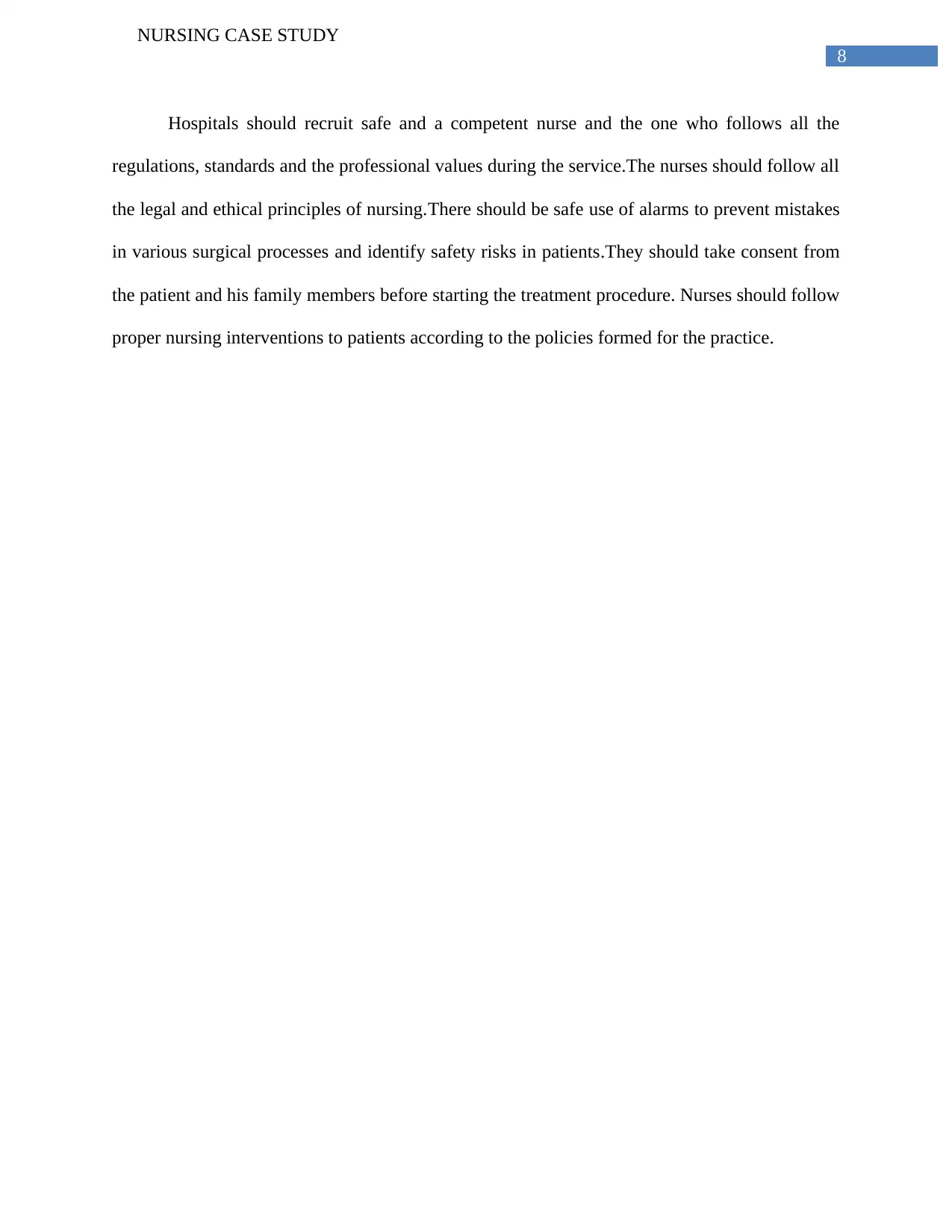
8
NURSING CASE STUDY
Hospitals should recruit safe and a competent nurse and the one who follows all the
regulations, standards and the professional values during the service.The nurses should follow all
the legal and ethical principles of nursing.There should be safe use of alarms to prevent mistakes
in various surgical processes and identify safety risks in patients.They should take consent from
the patient and his family members before starting the treatment procedure. Nurses should follow
proper nursing interventions to patients according to the policies formed for the practice.
NURSING CASE STUDY
Hospitals should recruit safe and a competent nurse and the one who follows all the
regulations, standards and the professional values during the service.The nurses should follow all
the legal and ethical principles of nursing.There should be safe use of alarms to prevent mistakes
in various surgical processes and identify safety risks in patients.They should take consent from
the patient and his family members before starting the treatment procedure. Nurses should follow
proper nursing interventions to patients according to the policies formed for the practice.
⊘ This is a preview!⊘
Do you want full access?
Subscribe today to unlock all pages.

Trusted by 1+ million students worldwide
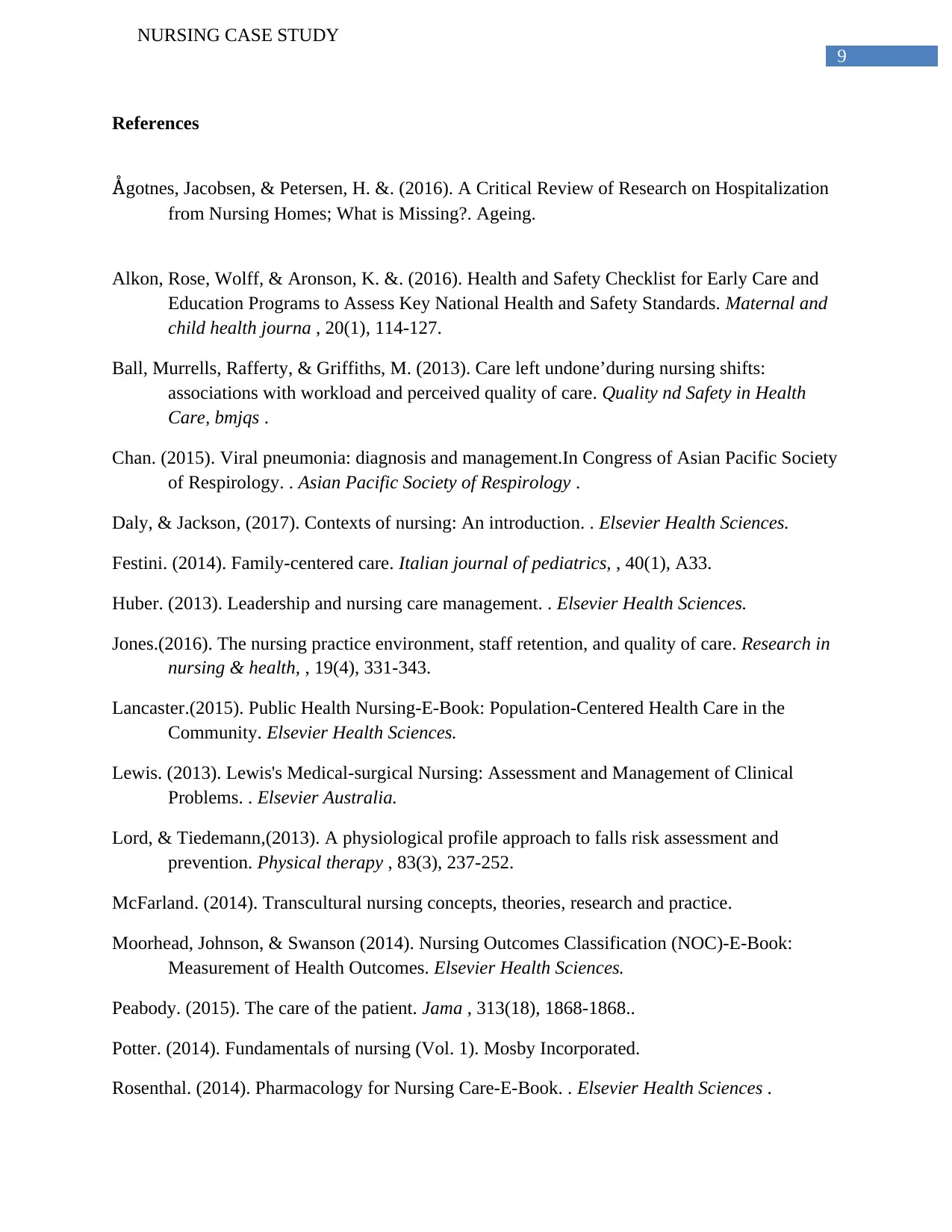
9
NURSING CASE STUDY
References
Ågotnes, Jacobsen, & Petersen, H. &. (2016). A Critical Review of Research on Hospitalization
from Nursing Homes; What is Missing?. Ageing.
Alkon, Rose, Wolff, & Aronson, K. &. (2016). Health and Safety Checklist for Early Care and
Education Programs to Assess Key National Health and Safety Standards. Maternal and
child health journa , 20(1), 114-127.
Ball, Murrells, Rafferty, & Griffiths, M. (2013). Care left undone’during nursing shifts:
associations with workload and perceived quality of care. Quality nd Safety in Health
Care, bmjqs .
Chan. (2015). Viral pneumonia: diagnosis and management.In Congress of Asian Pacific Society
of Respirology. . Asian Pacific Society of Respirology .
Daly, & Jackson, (2017). Contexts of nursing: An introduction. . Elsevier Health Sciences.
Festini. (2014). Family-centered care. Italian journal of pediatrics, , 40(1), A33.
Huber. (2013). Leadership and nursing care management. . Elsevier Health Sciences.
Jones.(2016). The nursing practice environment, staff retention, and quality of care. Research in
nursing & health, , 19(4), 331-343.
Lancaster.(2015). Public Health Nursing-E-Book: Population-Centered Health Care in the
Community. Elsevier Health Sciences.
Lewis. (2013). Lewis's Medical-surgical Nursing: Assessment and Management of Clinical
Problems. . Elsevier Australia.
Lord, & Tiedemann,(2013). A physiological profile approach to falls risk assessment and
prevention. Physical therapy , 83(3), 237-252.
McFarland. (2014). Transcultural nursing concepts, theories, research and practice.
Moorhead, Johnson, & Swanson (2014). Nursing Outcomes Classification (NOC)-E-Book:
Measurement of Health Outcomes. Elsevier Health Sciences.
Peabody. (2015). The care of the patient. Jama , 313(18), 1868-1868..
Potter. (2014). Fundamentals of nursing (Vol. 1). Mosby Incorporated.
Rosenthal. (2014). Pharmacology for Nursing Care-E-Book. . Elsevier Health Sciences .
NURSING CASE STUDY
References
Ågotnes, Jacobsen, & Petersen, H. &. (2016). A Critical Review of Research on Hospitalization
from Nursing Homes; What is Missing?. Ageing.
Alkon, Rose, Wolff, & Aronson, K. &. (2016). Health and Safety Checklist for Early Care and
Education Programs to Assess Key National Health and Safety Standards. Maternal and
child health journa , 20(1), 114-127.
Ball, Murrells, Rafferty, & Griffiths, M. (2013). Care left undone’during nursing shifts:
associations with workload and perceived quality of care. Quality nd Safety in Health
Care, bmjqs .
Chan. (2015). Viral pneumonia: diagnosis and management.In Congress of Asian Pacific Society
of Respirology. . Asian Pacific Society of Respirology .
Daly, & Jackson, (2017). Contexts of nursing: An introduction. . Elsevier Health Sciences.
Festini. (2014). Family-centered care. Italian journal of pediatrics, , 40(1), A33.
Huber. (2013). Leadership and nursing care management. . Elsevier Health Sciences.
Jones.(2016). The nursing practice environment, staff retention, and quality of care. Research in
nursing & health, , 19(4), 331-343.
Lancaster.(2015). Public Health Nursing-E-Book: Population-Centered Health Care in the
Community. Elsevier Health Sciences.
Lewis. (2013). Lewis's Medical-surgical Nursing: Assessment and Management of Clinical
Problems. . Elsevier Australia.
Lord, & Tiedemann,(2013). A physiological profile approach to falls risk assessment and
prevention. Physical therapy , 83(3), 237-252.
McFarland. (2014). Transcultural nursing concepts, theories, research and practice.
Moorhead, Johnson, & Swanson (2014). Nursing Outcomes Classification (NOC)-E-Book:
Measurement of Health Outcomes. Elsevier Health Sciences.
Peabody. (2015). The care of the patient. Jama , 313(18), 1868-1868..
Potter. (2014). Fundamentals of nursing (Vol. 1). Mosby Incorporated.
Rosenthal. (2014). Pharmacology for Nursing Care-E-Book. . Elsevier Health Sciences .
Paraphrase This Document
Need a fresh take? Get an instant paraphrase of this document with our AI Paraphraser
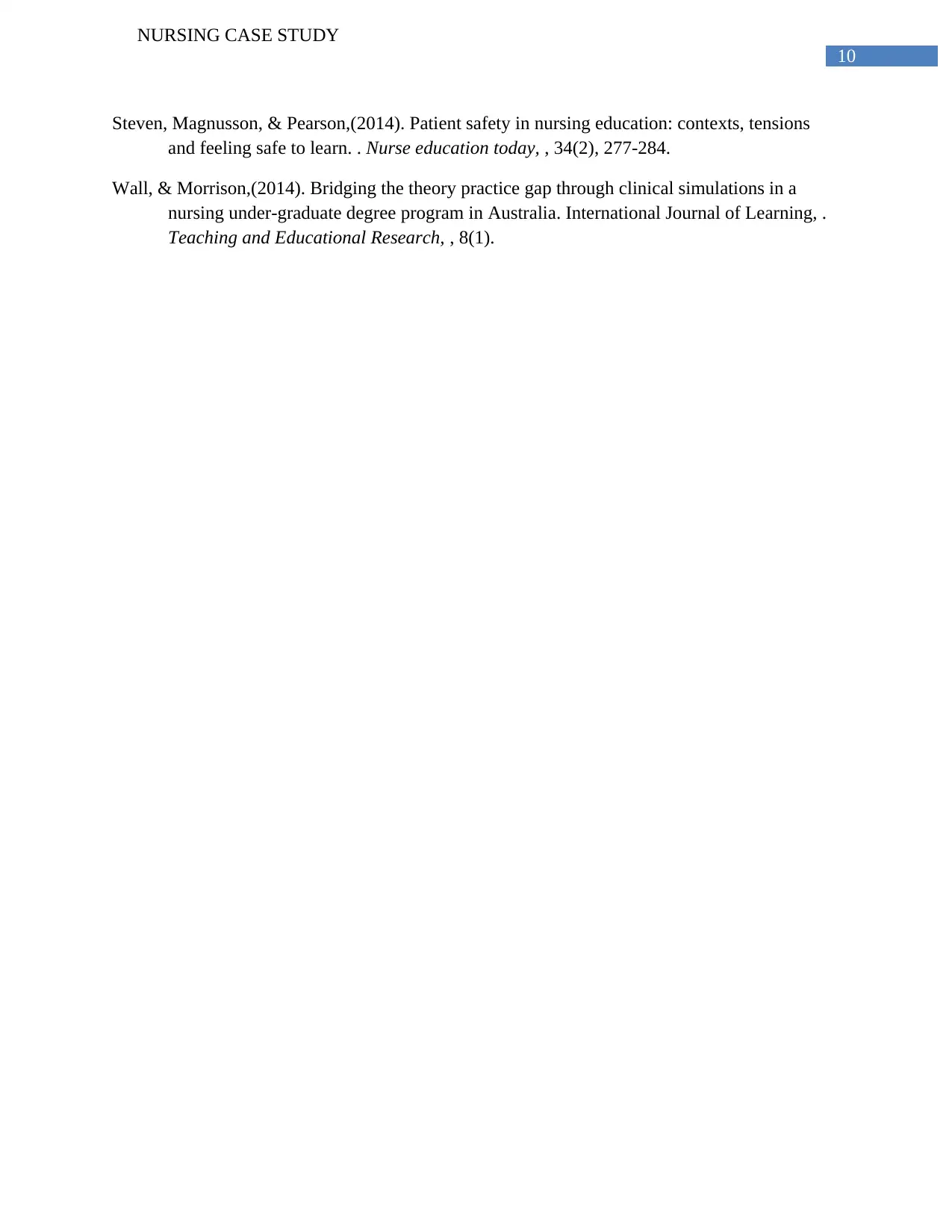
10
NURSING CASE STUDY
Steven, Magnusson, & Pearson,(2014). Patient safety in nursing education: contexts, tensions
and feeling safe to learn. . Nurse education today, , 34(2), 277-284.
Wall, & Morrison,(2014). Bridging the theory practice gap through clinical simulations in a
nursing under-graduate degree program in Australia. International Journal of Learning, .
Teaching and Educational Research, , 8(1).
NURSING CASE STUDY
Steven, Magnusson, & Pearson,(2014). Patient safety in nursing education: contexts, tensions
and feeling safe to learn. . Nurse education today, , 34(2), 277-284.
Wall, & Morrison,(2014). Bridging the theory practice gap through clinical simulations in a
nursing under-graduate degree program in Australia. International Journal of Learning, .
Teaching and Educational Research, , 8(1).
1 out of 11
Related Documents
Your All-in-One AI-Powered Toolkit for Academic Success.
+13062052269
info@desklib.com
Available 24*7 on WhatsApp / Email
![[object Object]](/_next/static/media/star-bottom.7253800d.svg)
Unlock your academic potential
Copyright © 2020–2025 A2Z Services. All Rights Reserved. Developed and managed by ZUCOL.





